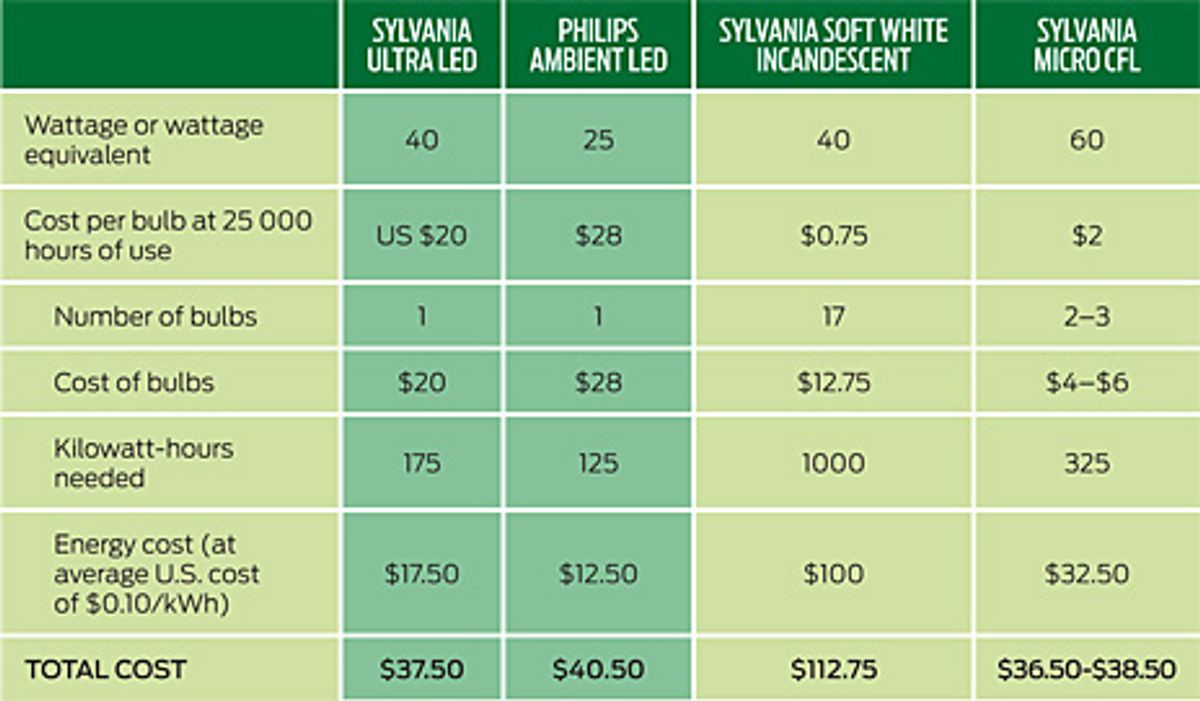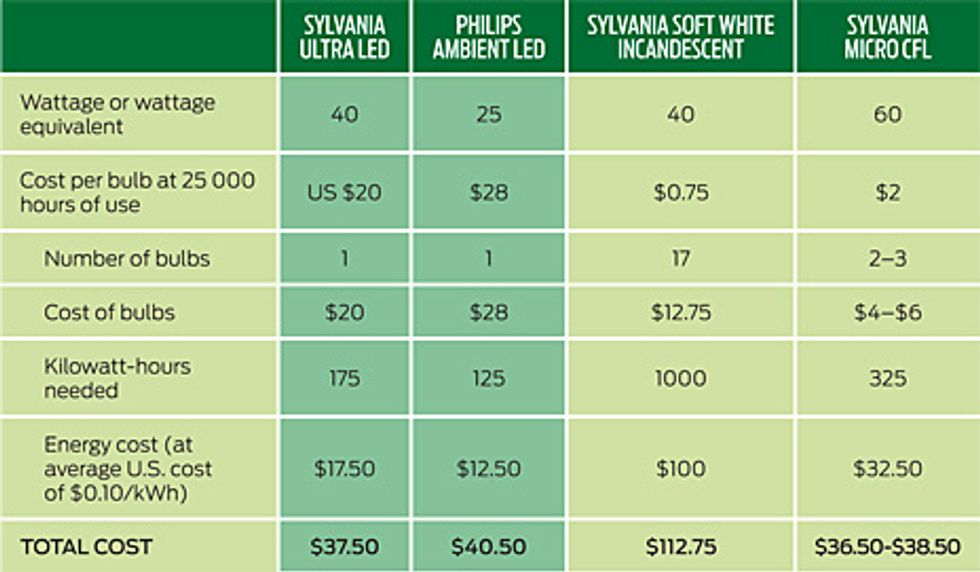Five years ago they were in the lab; now you can buy LED lightbulbs at a hardware store. Should you? They produce as much light as incandescent bulbs for less than a fifth the electricity and heat, they last up to 20 years, and they fit in standard sockets.
Even more important, today's models—unlike previous generations of superbright light-emitting diodes—produce a light that is natural enough to satisfy most incandescent buyers. Compact fluorescents, even in their warmer incarnations, produce spectra with a handful of sharp peaks. The spectrum of a warm-white LED, by contrast, is relatively smooth, much more like that of a glowing filament. LEDs also turn on instantly, with constant brightness, unlike CFLs. What's more, they beat CFLs where CFLs beat incandescents, by lasting even longer and saving you even more on your electricity bill. And, of course, an LED bulb looks much more like a regular lightbulb than does the CFL corkscrew.
Ironically, although LED bulbs produce far less heat than incandescents, dissipating what heat they do create is the primary factor limiting their brightness. LED bulbs, like other electronic equipment, must remain below 90 °C to get certification from Underwriters Laboratories. The drivers, the LED junction, and the phosphors might be able to withstand higher temperatures, but unless UL changes its rules, that's irrelevant.
That means the maximum heat budget for an LED, once it's stuffed into an A19 envelope (the iconic incandescent bulb shape that's been produced in the billions over the decades), is between 8 and 14 watts, says Ray Chock of Philips Lumileds Lighting Co. The high end of that range, however, requires more heat-sinking than is practical in consumer lighting. Current warm-white LED bulbs top out somewhere under 100 lumens per watt, compared with about 15 for incandescents, meaning the brightest current LED bulb is roughly equivalent to a 60-watt incandescent bulb.
By the end of 2012, lighting engineers expect LEDs to get 150 lumens per watt. But this number is complicated by the strong trade-off between color temperature and lighting efficiency. Color temperature is a measure of the spectral distribution of a light source; for incandescent bulbs it corresponds roughly to the surface temperature of the heated filament. Ordinary incandescent bulbs typically operate at about 2700 kelvin and produce the familiar yellow-white glow, while halogens, whose complex chemical process lets filaments run hotter and bluer, typically operate at about 3200 K.
For LEDs, things work a bit differently. The semiconductor itself produces a much bluer light than most consumers—especially those in the United States—want. So manufacturers lower the color temperature by painting on phosphors that absorb much of the blue and re-emit it as yellow and red light. But as more long-wavelength phosphors get added, more energy gets lost in the conversion process. Consider for example, LED manufacturer Cree's XLamp MX-3 bulb. It comes in a 6500-K version that produces roughly 94 lumens per watt, while a 3500-K version (only slightly bluer than halogen) emits a mere 77. So exactly how much efficiency you get depends on whether you want to feel like you're next to a cozy fireplace or under a cloudless arctic sky.
But enough of aesthetics. The real question about these new lights is economic: At US $20 to $70 a bulb, are LEDs worth the investment? Compared with incandescents, they certainly are. A $30 LED that's equivalent to a 40-watt incandescent will save 800 kilowatt-hours or about $80, over its rated 25 000-hour life, plus another $10 or so in replacement bulbs, plus whatever your time is worth to do the replacing. Compared with CFLs, though, LEDs aren't as economical: You'd save maybe 50 kWh and no more than $10 for replacements [see table, "A Worthy Investment?"]. The upshot is a quicker adoption of CFLs and a high-tech catch-22—if more people would acquiesce to the steep initial cost of LED bulbs, economies of scale would kick in, and prices would come down.
In truth, the economic analysis is a bit more complicated than that, because one of the premises of the payback calculation is that 25 000-hour life span. That's 10 or 20 human years—and not that many people or even businesses stay in the same location that long. In effect, LEDs are a capital investment, while incandescents and CFLs are consumables.
And these economics feed back into the technology in an interesting way. You might think that A19 envelope—and being able to fit your bulb into the billions of standard light sockets around the globe—would be a holy grail for LED developers. Not so. Much of their work involves ways to bypass standard sockets completely.
By making fixtures specifically designed to dissipate LED heat, engineers can pack more lumens into their bulbs. Consider the standard recessed ceiling fixture. For a retrofit LED bulb, it's the worst possible application because there's hardly any air circulation to carry away the heat. On the other hand, an LED-specific fixture can have heat-dissipating fins that extend invisibly for as much as several feet in each direction from the light source, something that Chock says Philips is working on. Custom designs for track lights and floor, table, and desk lamps can bring similar advantages.
So even as you try to figure out which of your current fixtures might be suitable for LED bulbs, expect them to be far more commonly seen at new stores, restaurants, and offices.

